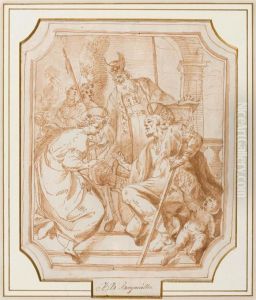Johann Baptiste Bergmuller Paintings
Johann Baptist (or Baptiste) Bergmüller was an influential German painter and engraver of the Baroque period, born in 1688 in Türkheim, Bavaria. His artistic journey began under the tutelage of his father, Thomas Bergmüller, also a painter. This early exposure to art within his family set the foundation for his future career. Bergmüller's work is notable for its dynamic compositions, vibrant use of color, and the incorporation of religious and mythological themes, reflective of the Baroque era's emphasis on emotion, movement, and detail.
Bergmüller further honed his skills by studying in Vienna, where he was exposed to the works of other Baroque artists, which significantly influenced his development as an artist. His talent and skill soon earned him recognition, and he became a leading figure in the Augsburg School of painting. Bergmüller's contributions to art were not limited to painting; he was also a master engraver, a skill that allowed him to reproduce his designs and spread his fame beyond the confines of Bavaria and Austria.
Throughout his career, Johann Baptist Bergmüller received numerous commissions for religious artworks, including altarpieces for churches and works for private devotion. His ability to blend spiritual themes with the dramatic intensity characteristic of the Baroque made his works profoundly impactful. In addition to religious art, Bergmüller also produced portraits, landscapes, and mythological scenes, showcasing his versatility as an artist.
Bergmüller's legacy is preserved in several important buildings and collections, including the churches and palaces of southern Germany and Austria. His contributions to the Baroque movement have been recognized by art historians, who regard him as a significant figure in the development of German Baroque art. Johann Baptist Bergmüller passed away in 1762, leaving behind a body of work that continues to be admired for its artistic excellence and emotional depth.
